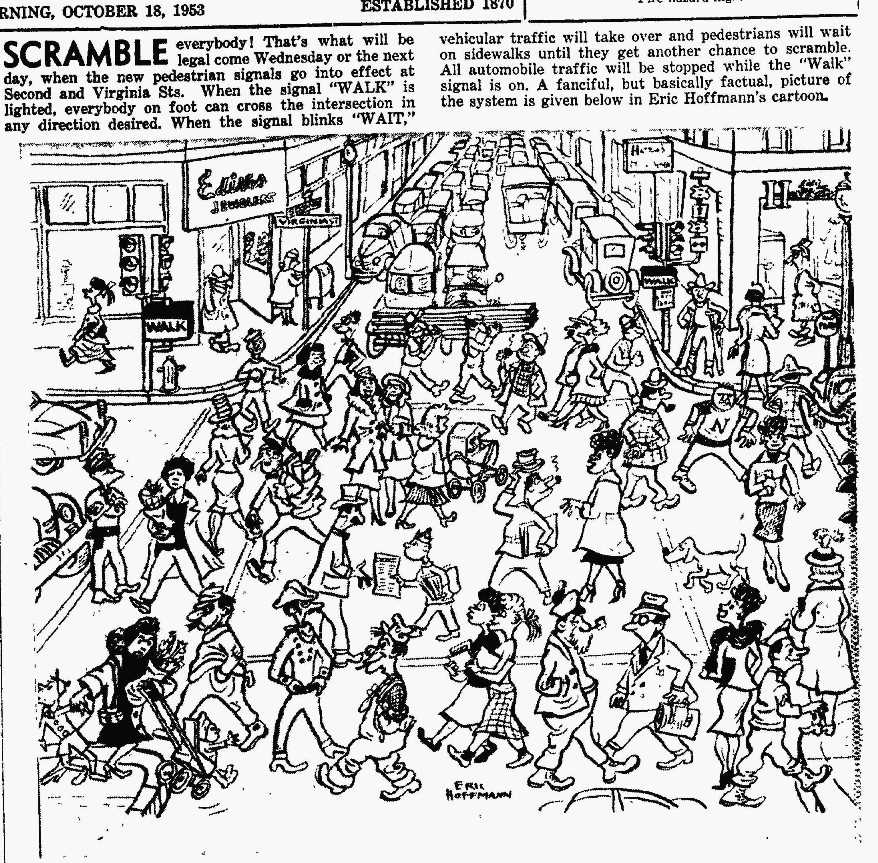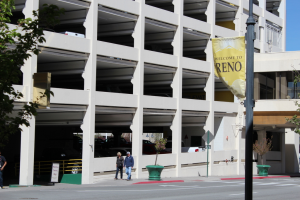I’m loving this 1953 cartoon from the Nevada State Journal introducing the new “scramble” system at the corner of 2nd & Virginia Street in Reno. The intersection was deemed Reno’s busiest at the time, and the artist has so clearly captured the vibrant pedestrian life of mid-century downtown. Students, stroller-pushing mothers, businessmen, shoppers, workers, cowboys, couples, soldiers–all sharing the streets in a democratic swirl of energy. As we strive to bring vitality & walkability to our downtown spaces, let’s not neglect the lessons we can learn from traveling the streets of the past.
Talking Walkability at TEDx
I had the great pleasure back in April of participating in a TEDx event at the Nevada Museum of Art. My complete talk can be viewed here but in short, I spoke about how and why to make our cities more walkable, mostly using examples from downtown Reno, the city where I live.
Knowing that it is the constant presence of people that brings an area to life and makes others want to spend time there, I first suggested two reasons why we should focus on making particular spaces in our cities more walkable (beyond the obvious universal goal of reducing our dependence on automobiles & everything that goes along with them):
- They may be iconic or otherwise well-known spaces that are most closely identified with the city, and therefore, in the minds of many, come to stand for the entire city, for good or bad.
- They may be at a physical crossroads, located between other desirable areas, making it critical that they be made both appealing and safe, to turn disconnected “pockets of walkability” into cohesive corridors.
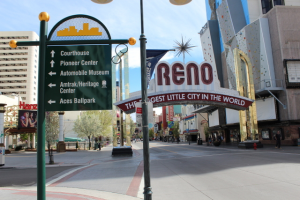
A Reno Arch has stood in the center of downtown Reno since the late 1920s, and the area is still the city’s most recognizable spot.
Reno’s central casino core fits both of these criteria; not only is it the home of the city’s most iconic image–the Reno arch–but it is the area most traveled by and known to tourists. Even more importantly to its residents, the casino core is directly at the center of four popular and walkable districts: the University of Nevada (to the north), Truckee River/Midtown (south), Aces ballpark and the emerging shops/restaurants/clubs of Fourth Street (east) and thriving Riverwalk district/kayak park (west).
In the effort to make such areas more walkable, I suggested a need to consider three primary factors: variety, scale, and connection. In terms of variety, the environment needs to ensure variety in appearance, function, and people. Basically, it needs to attract a variety of people all hours of the day–shoppers, businesspeople, families with children, tourists, and residents. That’s the only way a place can feel both safe and authentic. So what to do? Encourage and support a variety of businesses, particularly development that caters to different uses at different times of day–street-level business with apartments above; live/work spaces, coffee shops, restaurants, museums, retail of all types.
The scale needs to be people-friendly; no one enjoys walking in a space that seems tailored for cars. Parking garages, block-long solid edifices with no individual storefronts or visual interest…these are both soul-deadening and dangerous, since they offer no opportunity to create a constant movement of people in and out of city blocks, adding a constant influx of pedestrians to the sidewalk.
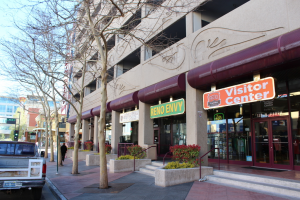
Street-level retail adds visual interest to parking garages, and attracts a variety of people to a block’s various storefronts. This stretch contains a restaurant, a combination visitor center/popular retail shop, a post office, and more.
Connection means paying attention to how pedestrians use these spaces, in order to encourage greater use. Create attractive anchors that can visually draw people from one destination to the next. Make walking enjoyable. If you need parking garages, at least place commercial storefronts on street level (and why not do that in the hotel-casinos, too?); make sidewalks functional; prioritize infill projects to eliminate shadowy vacant lots and deteriorating properties that make people uncomfortable and can promote undesirable activity. It’s amazing how far people will walk if they find the experience enjoyable and safe (we’ll walk for hours through a shopping mall–the equivalent of several city blocks–and yet often balk at having to walk two blocks from a parking space to a restaurant!).
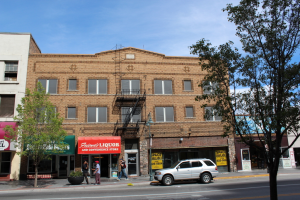
When you consider walkability your primary goal, you can see potential everywhere. Every building is full of possibility.
You may be thinking hey, that sounds great, but I’m not an urban planner, or an architect, or a business owner who might want to relocate to one of these areas–so what can I do? Easy. Go to these critical areas, park your car and walk around. See what’s already going on down there. Take a walking tour. Support the effort. Tell other people about it. Pay attention to what is being proposed in these areas, and ask yourself if it meets these criteria. Participate in the process. When walkability is the goal, you literally carry the solution with you, in your own two feet.
The Biggest Little City
I’ve seen and read a lot about Reno’s image through the years–concerns about the city’s persistent “identity crisis,” complaints about its unfair reputation, its incessant mocking by everyone from the Muppets to David Sedaris. Heck, I even wrote a book about it. We’re the city with a communal chip on its shoulder, ever crouched in a defensive stance, fists up, already flinching in expectation of the next jab.
But yesterday felt consequential, with the unveiling of a new grassroots marketing campaign, spearheaded by an alliance of creative professionals in advertising, PR & communications, but clearly intended to embrace citizens from all fields & backgrounds in a massive outpouring of civic pride: The Biggest Little City.
This campaign stands out for a number of reasons: first, it embraces the city’s longstanding nickname, the Biggest Little City in the World–one of its most recognizable and enduring assets.
Second, it echoes the very origins of the nickname itself, which was not born in 1929 when a Sacramento man won a contest to come up with a slogan for the Reno arch, as is often reported. G.A. Burns’ suggestion did win the contest, but the phrase had already been introduced to the world by the town’s own business community, nearly twenty years earlier.
The summer of 1910 was huge for Reno. That July, the city hosted the heavyweight championship of the world, pitting Jack Johnson against the hopelessly outmatched returning champ, Jim Jeffries, in a bout that gained global attention, not least for its divisive racial politics. The city’s divorce industry was in full swing, and the state was enjoying what was thought to be its last season of legalized gambling, after the 1909 state legislature approved the prohibition of all gambling, effective October first, 1910.
All eyes were on Reno, and its citizens knew it. That fall, the Reno Business Men’s Association and the Commercial Club met the attention with a booklet featuring an image of the globe and the words “Reno, The Biggest Little City on the Map.” As the local paper reported that year, people were already replacing “map” with “world,” noting, “Isn’t that something to be proud of? It is a merited title, to a certain extent, but should be earned in its entirety. It is the duty of every public spirited citizen…to make the title true.”
What made Reno so big for its modest population of approximately 11,000? The booklet outlined it all: its economy, beauty, climate, recreational opportunities, community spirit, university, and abundant energy. The Biggest Little City–not a tourist slogan chosen by an outsider, but a badge of honor, generated from within, encouraging every resident to help spread the word–to “make the title true.” Everything old is new again. Hear hear.
Oral History Online
This week we’re launching the new website for the published collection of the University of Nevada Oral History Program (UNOHP), which I have directed since July 2009. The website can be found here, and we’re still loading transcripts and tweaking various search functions, but we’ve decided that it’s complete enough for people to begin exploring, and I couldn’t be more proud.
We have items in the collection dating back to 1965, the first year interviews were conducted after the program was founded in 1964. We’ll be adding other transcripts over the next month, for a total of more than 700 interviews on topics ranging from cattle ranching to community bike shops. The earliest interviewees were born in the 1880s, giving us an incredible record of the entire twentieth century, and in some cases, even earlier.
I’ll be posting about selected items from the collection all week, and on this Memorial Day, it seems fitting to highlight the World War II Veterans Project, a compilation of oral history interviews with 17 Nevada veterans of World War II who bravely served throughout the world. Their words, like those of so many others in the collection, tell a story not just of Nevada, but of America. I am thrilled that they are now available for everyone to appreciate and enjoy.
The Art of the Casino
I’m excited to announce an event in which I’ll be participating this coming Friday, May 17th. It’s the May salon, “The Art of the Casino,” sponsored by Nevada Humanities, to be held at Sundance Books & Music in Reno at 6:30 p.m. More details on the event here.
This monthly series is inspired by their namesake gatherings of old, when people of wide & varied interests met together to share lively conversation about the topics of the day. They are stimulating (literally and intellectually–there’s wine!), and always draw an ebullient crowd.
This Friday’s salon, “The Art of the Casino” is particularly inspired for our time and place, and will feature David Kranes and Susan Chandler. I’ll moderate and round out the panel. We’ll give our panelists a chance to share their thoughts and then we’ll all chime in.
 David is an award-winning writer, playwright, and professor emeritus of Creative Writing from the University of Utah, who has written many pieces inspired by Nevada’s gambling landscape, including the novel Keno Runner. He is also a creative design consultant for casinos, giving him terrific insights on creating art both in and from the casino environment.
David is an award-winning writer, playwright, and professor emeritus of Creative Writing from the University of Utah, who has written many pieces inspired by Nevada’s gambling landscape, including the novel Keno Runner. He is also a creative design consultant for casinos, giving him terrific insights on creating art both in and from the casino environment.
Susan, an associate professor in UNR’s School of Social Work, is co-author of the new book, Casino Women: Courage in Unexpected Places, which incorporates interviews with maids, cocktail waitresses, cooks, laundry workers, dealers, pit bosses, and vice presidents, into a pioneering look at women in the casino world. 
What will we discuss? Whatever comes to mind! How casinos shape the visitor experience, who holds the power within them and how those dynamics have changed, why casinos look and feel the way they do, and what we all see as the future of casinos, their workers, and their communities as legalized gambling expands throughout the country and the world. Please join us and add your voice to the conversation!
